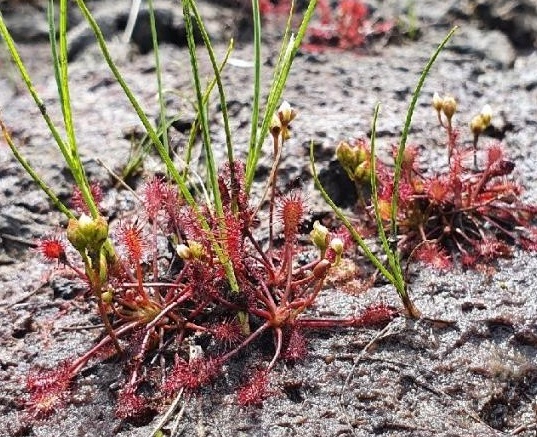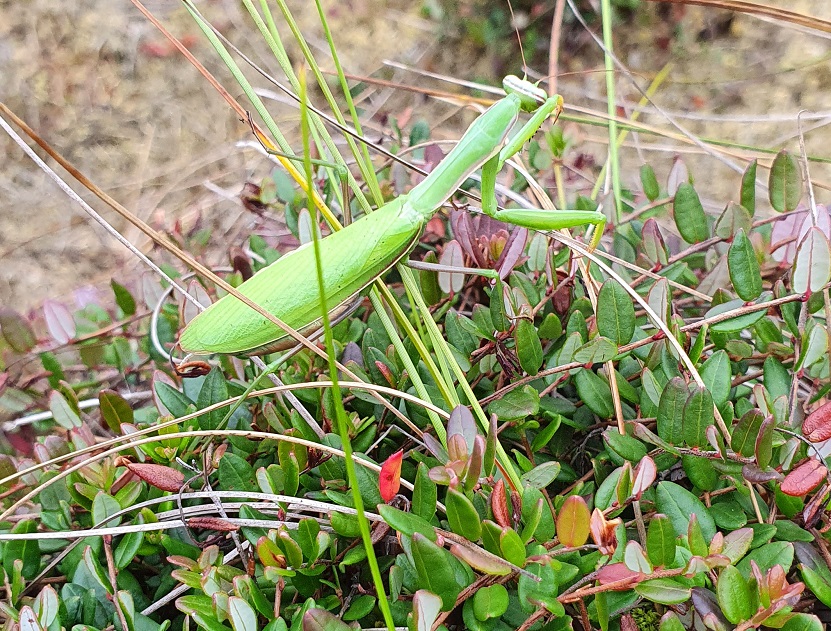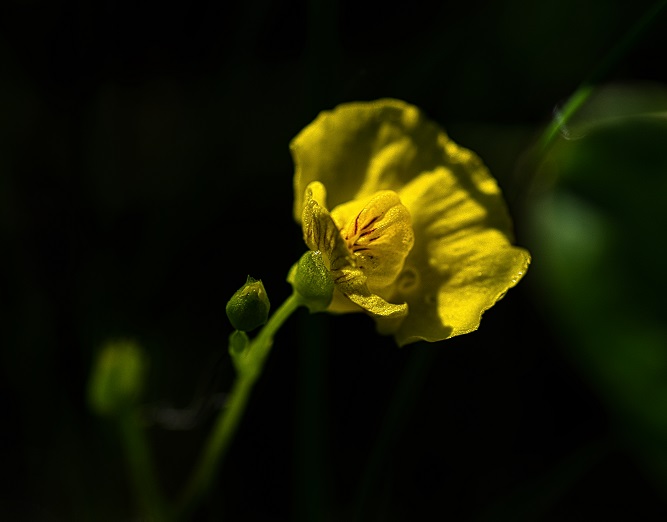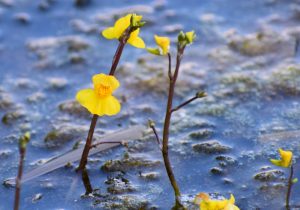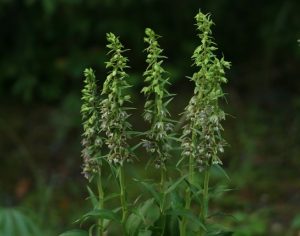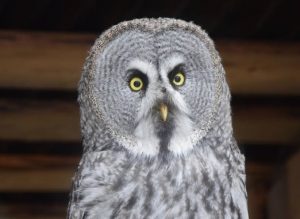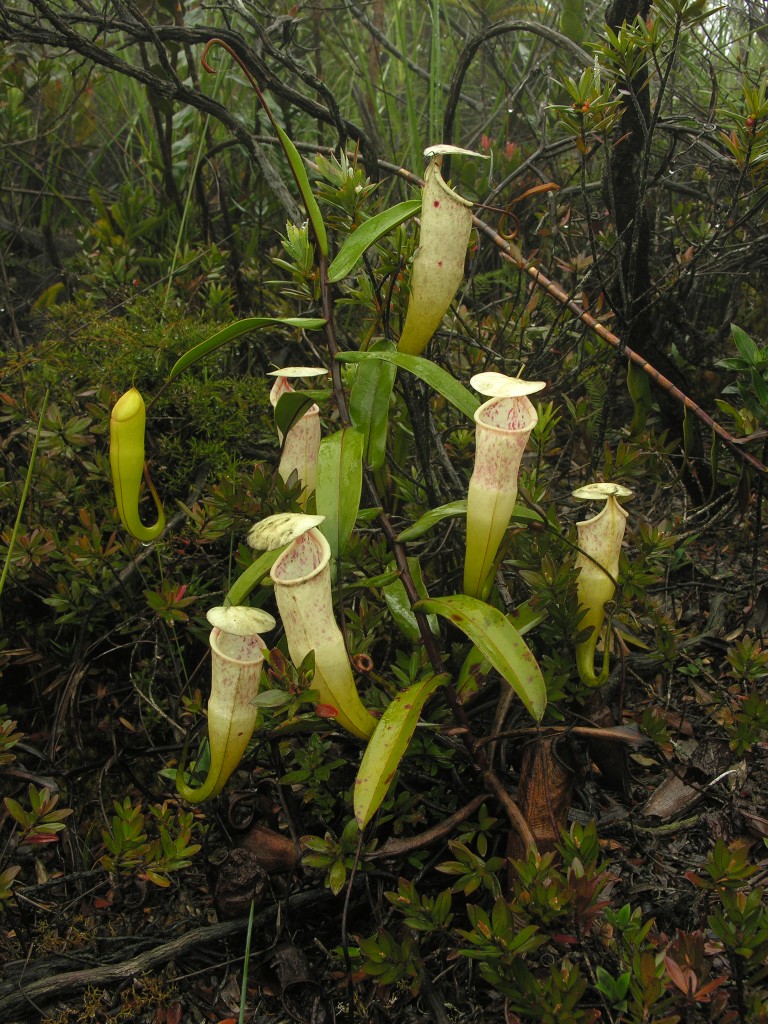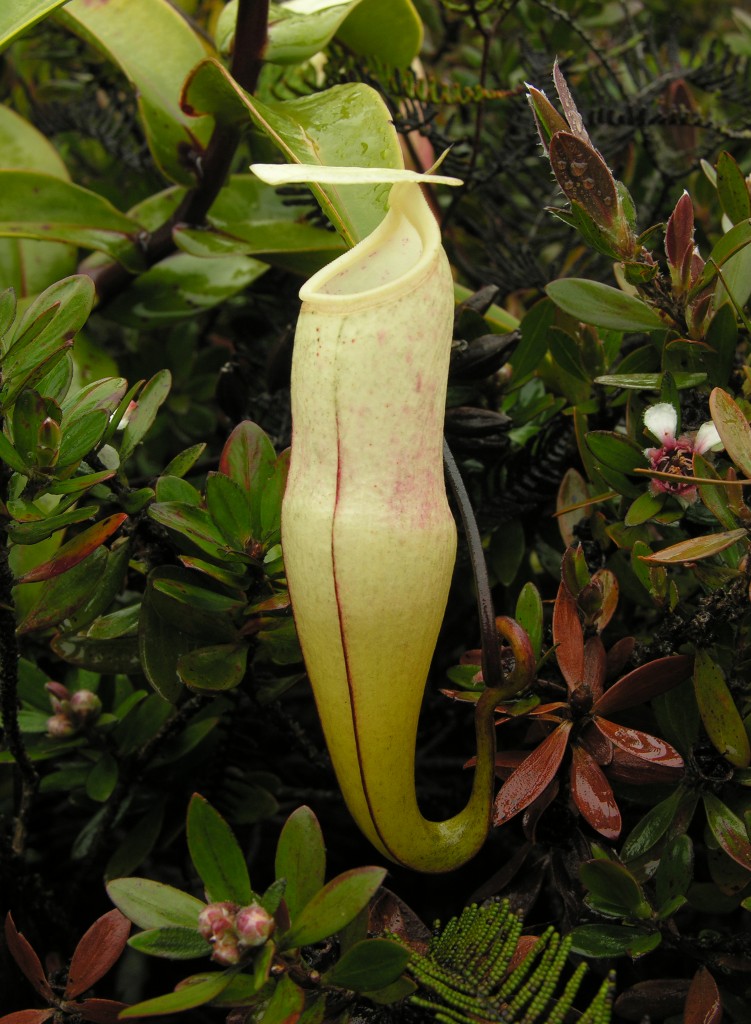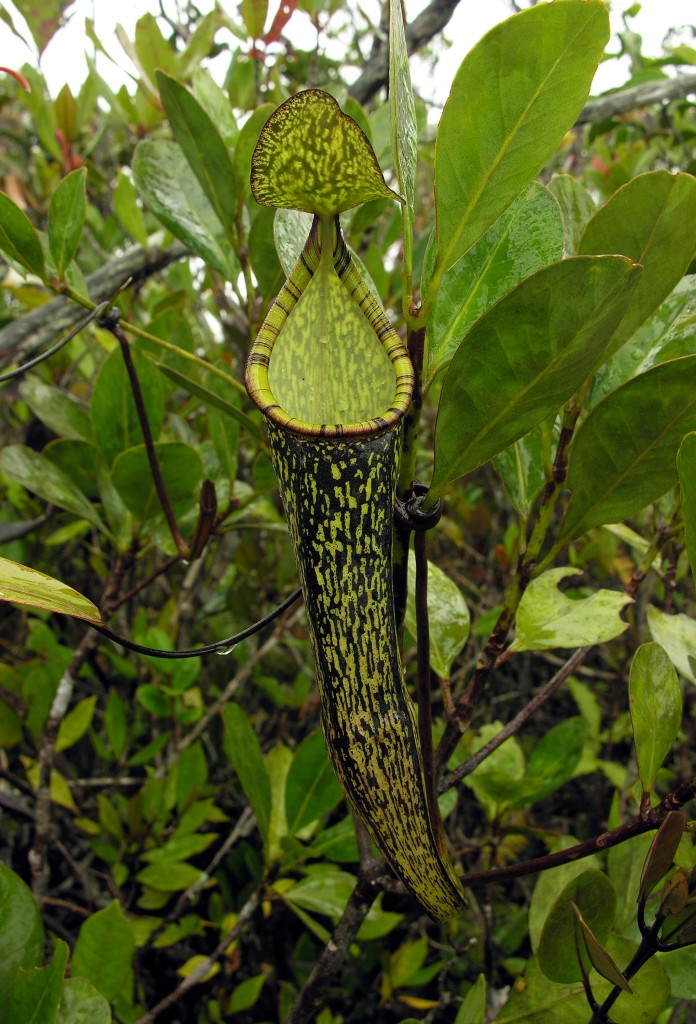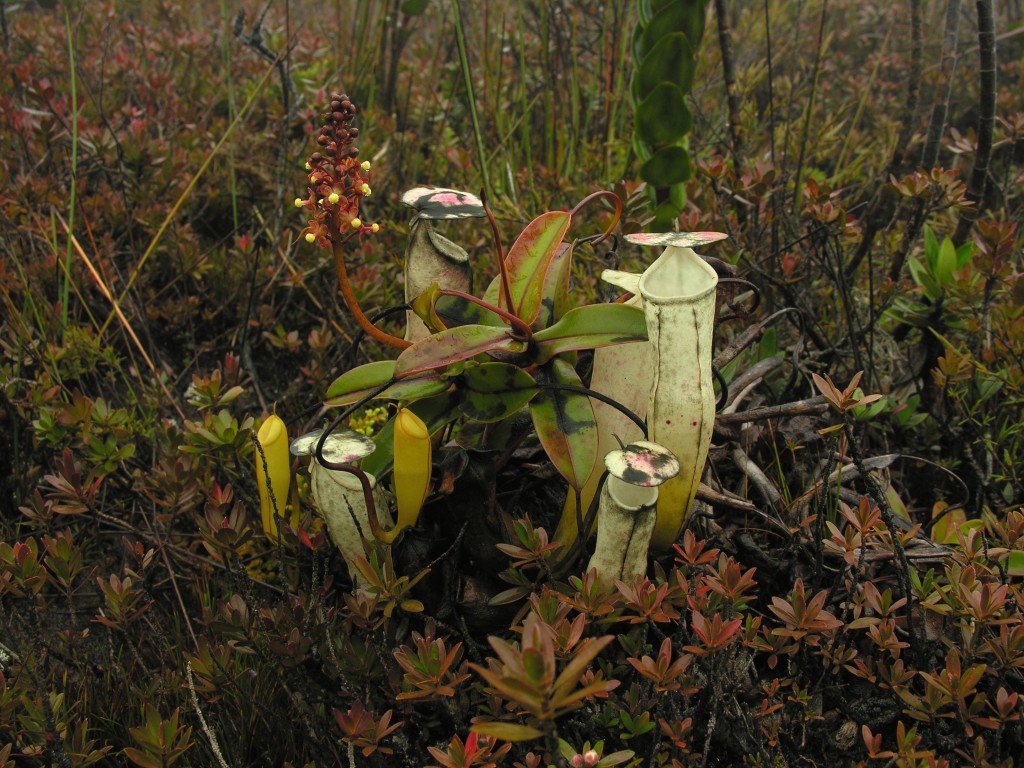One century ago, the English botanist Henry Ridley traveled to Malaysia and climbed Mount Tahan in (what is now) Pahang. During his climb, Ridley discovered two species of pitcher plants (Nepenthes). He named the first on N. gracillima in 1908, and recorded that it produces long, slender pitchers that are predominantly black mottled with green blotches. Sixteen years later, Ridley described the second species which he encountered, and he named this plant N. alba for it produces smaller, predominantly white pitchers.
During the one hundred years since Ridley’s work, the classification of these two plants has been clouded with errors and confusion. Various botanists have considered the two plants the same species, others mistakenly identified either or both under incorrect names, including N. ramispina, N. bongso and N. singalana.
In 2008, I travelled to Mount Tahan to attempt to understand the taxonomy of the Nepenthes of that mountain. I observed populations of two distinct types of Nepenthes on the upper slopes of Mount Tahan, both of which were consistent with Ridley’s original descriptions of N. gracillima and N. alba. The pitchers of these plants differ in shape, size and colouration, and they predominantly occur at different altitudes and in distinct habitats. As far as I observed, they do not hybridize or introgress and are easily distinguished from one another. On the basis of my observations, I concluded that Ridley’s original classification of these two plants as distinct species is correct, and N. alba and N. gracillima are indeed different species.
N. alba is named after the Latin albus (white). The name refers to the colouration of the upper pitchers of this plant. N. alba is widespread across the upper slopes of Mount Tahan, in Taman Negara (Malaysia’s largest national park) and it occurs with increasing abundance from 1,600 m altitude to the summit of the mountain, which stands at 2,187 m. The population of N. alba on Mount Tahan consists of many tens of thousands of plants which display consistent morphology, size, and general colouration (although the upper pitchers vary in colour). The wider distribution of N. alba beyond Mount Tahan remains unclear but herbarium specimens from Mount Tapis represent this species.
At lower elevations, N. alba grows amidst stunted, upper montane forest and scrub, mainly on ridge tops and the upper slopes of the mountain. It produces a branched stem up to 5 m long and scrambles and climbs amidst surrounding vegetation, and mostly grows in strong or direct sunlight. At higher elevations (especially on the upper slopes of Mount Tahan), it grows amidst stunted scrub or in exposed areas, devoid of vegetation, and often forms a compact rosette or short scrambling stem that trails across the ground. On the summit of the mountain, large populations of N. alba grow in waterlogged, marshy areas, amidst short marsh grasses and orchids. In such exposed conditions, the N. alba plants are greatly dwarfed and flowering specimens just 25 cm tall are often observed.
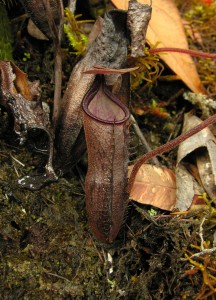 The lower pitchers are up to 12 cm long and 4.5 cm wide (although usually are much smaller than these maximum measurements). The bottom half of the pitcher is ovate and slightly swollen. Above this part, the width of the pitcher narrows (usually with a distinct hip) and the rest of the trap is cylindrical or very slightly infundibular towards the pitcher opening. Wings up to 7 mm wide, fringed with filaments up to 10 mm long run down the front of the lower pitchers. The peristome is up to 8 mm, and is lined with ribs up to 1 mm high, spaced up to 1 mm apart. The peristome is cylindrical and narrow at the front of the pitcher opening, and expanded and flattened at the back (especially below the lid). The peristome ribs are elongated along the inner edge of the peristome and form spikes up to 2 mm long, which extend into the pitcher opening. The lid is sub–orbicular or elliptic, up to 4 cm wide, 3.8 cm long and lacks an appendage. The spur is generally unbranched and up to 13 mm long.
The lower pitchers are up to 12 cm long and 4.5 cm wide (although usually are much smaller than these maximum measurements). The bottom half of the pitcher is ovate and slightly swollen. Above this part, the width of the pitcher narrows (usually with a distinct hip) and the rest of the trap is cylindrical or very slightly infundibular towards the pitcher opening. Wings up to 7 mm wide, fringed with filaments up to 10 mm long run down the front of the lower pitchers. The peristome is up to 8 mm, and is lined with ribs up to 1 mm high, spaced up to 1 mm apart. The peristome is cylindrical and narrow at the front of the pitcher opening, and expanded and flattened at the back (especially below the lid). The peristome ribs are elongated along the inner edge of the peristome and form spikes up to 2 mm long, which extend into the pitcher opening. The lid is sub–orbicular or elliptic, up to 4 cm wide, 3.8 cm long and lacks an appendage. The spur is generally unbranched and up to 13 mm long.
The colouration of the lower pitchers is very consistent. The exterior surface of the pitcher is dark purplish brown, often mottled with faint dark purple blotches. The interior of the trap is uniformly light purple, sometimes with faint purple blotches. The lid (both sides) is light purple or reddish. The peristome is dark purple or black.
The upper pitchers are up to 13 cm long and 4 cm wide (although usually are much smaller than these maximum measurements). The bottom half of the pitcher is narrowly infundibular or ovate. Above this part, the width of the pitcher narrows (usually with a distinct hip) and is cylindrical towards the pitcher opening. Wings are reduced to narrow ridges which run down the corners of the flattened front face of the trap. The peristome is up to 7 mm wide and is slightly expanded at the sides and back of the pitcher opening, or not at all. The peristome is lined with fine ribs up to 0.5 mm high, spaced up to 1 mm apart (although often the peristome ribs may be hardly discernable at all). All other parts are consistent with the lower pitchers.
The exterior and interior of the upper pitchers is predominantly white in colour, although the bottom half of the trap may suffuse yellowish green towards the base. Red or pink blotches and flecks are usually present either on the interior or exterior of the upper pitchers (or on both surfaces) although the extent and density of this colouration is extremely variable (see below). The vestigal wing ridges which run down the front of the pitcher may be dark purple or may have no colouration at all in plants which produce pure white pitchers. The peristome is usually pure white, sometimes striped with bands of red, or suffused pinkish. The lid may be pure white, or mottled with red or pink blotches, or suffused reddish.
The colouration of the upper pitchers of this species is extremely variable. 90% of N. alba plants produce pitchers that are predominantly white with some red or pink blotches on the exterior or interior of the trap. Approximately 9% of the total wild population on Mount Tahan produces upper pitchers which are consistently pure white. The remaining 1% produce upper pitchers that are very heavily lined with red blotches to the extent that they appear predominantly pure red, pink or orange in colour.
N. gracillima derives its name from the Latin gracilis (slender, narrow) and illimus (very), which refers to the shape of the upper pitchers. N. gracillima is currently known only from the upper slopes of Mount Tahan, and it seems to be much rarer than N. alba. All known populations of N. gracillima occur amidst upper montane scrub on humid ridge tops between 1,600–1,700 m altitude. It is not widespread or populous on Mount Tahan, and most populations consist of just a few dozen plants (but these are consistent and uniform). N. gracillima readily forms a branched stem up to 3 m long, and scrambles and climbs amidst surrounding vegetation, particularly in areas where it may grow in strong or direct sunlight. In contrast to N. alba, N. gracillima does not grow on the ground in open, exposed habitat or grow in exposed areas and form stunted, compact foliage.
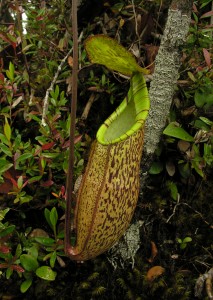 The lower pitchers are up to 22 cm long and 7 cm wide. The bottom half of the pitcher is ovate and broad. Above this part, the trap narrows slightly (or hardly at all) with a faint hip (or no hip at all) and becomes cylindrical towards the pitcher opening. Wings up to 9 mm wide fringed with narrow filaments up to 1 cm long run down the front of the pitcher. The peristome is glossy, up to 1.8 cm wide, and is narrow at the front of the pitcher opening, but expanded at the sides and back, especially below the lid. A gap a few milimeters wide may be present in the back of the peristome, immediately below the lid. The peristome with conspicuous ribs up to 1.5 mm high, spaced up to 1.5 mm apart. The inner margin of the peristome extends into the pitcher opening for several milimeters. The peristome ribs are elongated along the inner edge of the peristome and form spikes up to 2 mm long, which extend into the pitcher opening. The lid is elliptic or ovate, up to 6 cm long and 5 cm wide and lacks an appendage. The spur is usually unbranched and up to 2 cm long.
The lower pitchers are up to 22 cm long and 7 cm wide. The bottom half of the pitcher is ovate and broad. Above this part, the trap narrows slightly (or hardly at all) with a faint hip (or no hip at all) and becomes cylindrical towards the pitcher opening. Wings up to 9 mm wide fringed with narrow filaments up to 1 cm long run down the front of the pitcher. The peristome is glossy, up to 1.8 cm wide, and is narrow at the front of the pitcher opening, but expanded at the sides and back, especially below the lid. A gap a few milimeters wide may be present in the back of the peristome, immediately below the lid. The peristome with conspicuous ribs up to 1.5 mm high, spaced up to 1.5 mm apart. The inner margin of the peristome extends into the pitcher opening for several milimeters. The peristome ribs are elongated along the inner edge of the peristome and form spikes up to 2 mm long, which extend into the pitcher opening. The lid is elliptic or ovate, up to 6 cm long and 5 cm wide and lacks an appendage. The spur is usually unbranched and up to 2 cm long.
The exterior of the lower pitcher is predominently yellowish green, with variable, dark red or purple blotches. The peristome is green or reddish, often striped with bands of dark red or purple. The interior of the pitcher light and lower surface of the lid are yellowish green or light yellow. The upper surface of the lid is olive green, with variable dark purple or black flecks. In all populations of N. gracillima which I observed, the colouration of the lower pitchers was consistent (as described above).
The upper pitchers are up to 26 cm long and 5 cm wide (many times larger than the typical size of the upper pitchers of N. alba). The traps are wholly infundibular, although extremely narrowly so, and greatly elongated. Sometimes, the bottom third of the pitcher may be slightly swollen, with a very faint hip above. Wings are reduced to narrow ridges which run down the corners of the abruptly flattened, angular front face of the trap. The peristome is up to 12 mm wide and is slightly expanded at the sides and back of the pitcher opening, or not at all. The peristome is lined with fine ribs up to 0.5 mm high, spaced up to 1 mm apart (although often the peristome ribs may be hardly discernable at all). All other parts are consistent with the lower pitchers.
The exterior of the upper pitcher is predominantly black, mottled with variable bright green blotches (which are elongated towards the base of the trap). This colouration is also present on the upper surface of the lid, however the lower surface of the lid and interior of the pitcher are light yellowish green. The peristome is yellow, striped with narrow bands of black and purple.
The discovery of these two spectacular and very beautiful pitcher plant species on Mount Tahan raises many questions as to whether both also occur widely across the many peaks of central Peninsula Malaysia, and beyond. Both N. alba and N. gracillima occur within responsibly and strictly managed protected areas and are not currently threatened with extinction.
Stewart McPherson
